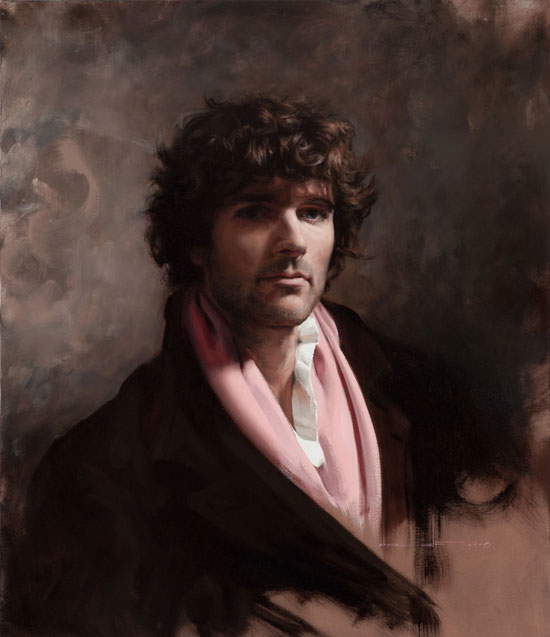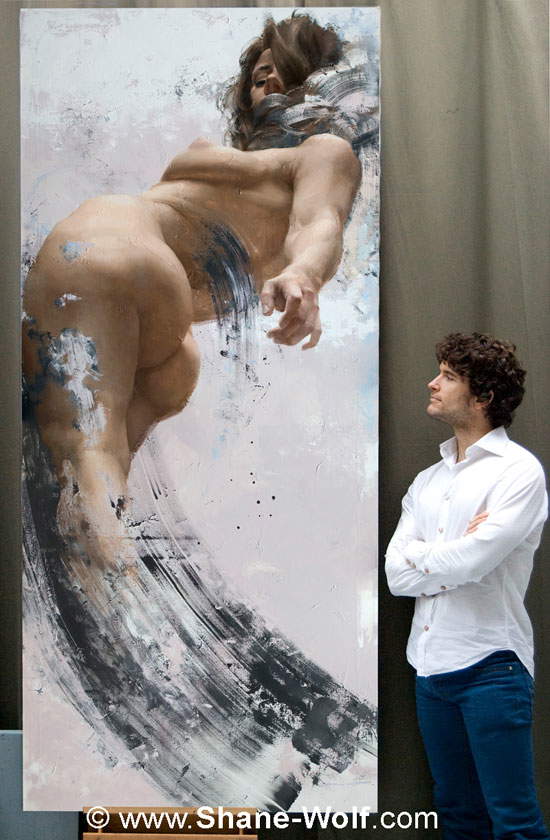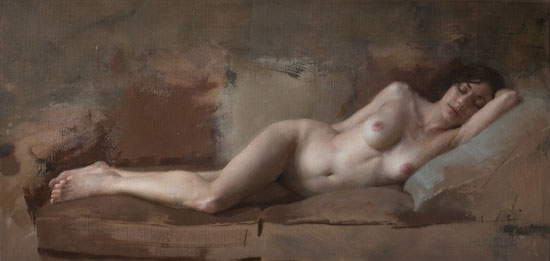The human form is the pinnacle of beauty: interview with Shane Wolf
Among the most interesting artists on the international scene, one of our favorites is Shane Wolf (Cincinnati, USA, 1976). An imaginative and versatile artist with a highly refined technique, who trained in Italy (and particularly in Florence) and currently lives and works in Paris. An artist who reworks the great art of the Renaissance in a modern and innovative key. We had the pleasure and honor of interviewing him, asking him some questions about his art. It resulted in a very interesting conversation, which our Ilaria translated from English. We thank Shane Wolf, with the hope that this interview may make you appreciate a great international artist as much as we do!
 |
| Shane Wolf, In the Grand Manner, self-portrait (oil on cotton, 70 x 60 cm) © Shane Wolf |
From the Florence of the Renaissance, where you were artistically trained, to France, which in the nineteenth century retraced at length the art of Raphael, Michelangelo and all the greats of sixteenth-century Italy: can we consider Shane Wolf an Italian artist? What prompted her to reflect so passionately on the art of our past? Also, what was it that brought you to Paris?
I am not really sure I can be considered an Italian artist, but certainly my taste for classical art woke up and began to develop during my stay in Italy. Very often they say that my works are influenced by Italy, and many people claim to see the roots of the Renaissance in my paintings. Personally, I think these remarks are definitely due to the fact that I studied in Florence, where the Renaissance is tangible, where you can walk down a narrow street and happen to run into a Donatello or a Verrocchio or a Brunelleschi. These influences are everywhere and they certainly had a strong impact on my artistic vision.
After Florence, Paris was clearly the right city for me. Florence is a wonderful city to study in, while Paris seemed to be the right place for me to become a professional. I needed a city that had an extraordinarily rich past but also a vibrant present. Paris offered that right combination of richness and vibrancy both in terms of the past and the present.
 |
| Shane Wolf with his painting Venus (oil on canvas, 223.6 x 100 cm) © Shane Wolf |
The reworking of Renaissance art also comes through techniques: she makes great use of drawing but her production also abounds with foreshortened figures that recall the great illusionist painters of the sixteenth century, such as Correggio and Veronese. In an age when art is made in any medium of expression, how important is it to return to traditional techniques?
In my creations, it is absolutely essential to use traditional techniques. Drawing and painting from life is in itself beautiful and also great humanistic values abound. When you work solely from life as I do, you can better understand why the Renaissance was also a humanistic cultural change. Those who spend days and years studying the forms of Humanism in all their complexities (well, it’s not really possible, but we try!) become part of the great lineage of art history, going all the way back to the ancient Greeks. I think that’s why great works of art still speak to us so profoundly: they tap into certain fundamental human feelings and values.
And yes, glimpses are certainly an important part of my art. I admire and respect so much the illusionist painters you mention (even Tiepolo) and I also strive to challenge myself with unpredictable views of the model. Not only is it a fun challenge, but it often provides an incredible representation of the subject.
Not only modes, but also themes: your “Eidolon” series proposes the recovery of typical subjects from ancient art (Venus, Voici l’homme. In what way do you think a recovery of these themes is reconcilable with the present and current events?
Good question! I will talk about Venus first, then Voici l’homme. As a painter, I am more interested in creating paintings for the present day, for the 21st century. I do not wish at all to make a painting that looks like it could have been made in the past. It is certainly very interesting the irony of us painters of today trying to speak to the present by recalling themes and techniques of the past.
Venus has of course been depicted by painters of many disciplines and various levels of greatness. In choosing to paint Venus, I choose to add my vision to the dialogue rooted deeply in the past: a Venus for the twenty-first century. The idea of Venus is timeless, and therefore as appropriate today as it was for Bouguereau, Botticelli or Praxiteles.
Voici l’homme is very important to me because it is based on a deeply rooted philosophy. I totally reject the Christian view in its condemnation of humankind: that is, that man is born in sin and is obliged to behave well (born in sin and must find salvation or perish in eternal suffering). I find this to be a sad and utterly immoral worldview. Traditionally, Ecce Homo the moment Christ is presented to the crowd by Pontius Pilate is depicted as a bleak, ominous, gloomy image. Surely this is the appropriate image according to the Christian view.
Since I do not agree at all with this idea that man is born in sin, such an important theme as Ecce Homo still needs another representation, a representation that does not adhere to Christian doctrine. Imagine: THIS IS THE MAN. What power! What nobility! What magnificence! My Voici l’homme is my humanistic response to the traditional theme. As with Venus, my aim is to create images that speak of our time, that touch the strings of my fellow human beings. And sometimes the great themes of the past allow us to do that.
 |
| Shane Wolf, Daydream II (oil on linen canvas, 100 x 50 cm) © Shane Wolf |
In his paintings, the great protagonist is the human body. In the French magazine Dessine et Peinture, in 2014, she said that in her opinion the body expresses all qualities: magnificence, strength, elegance, sensitivity. Bodies that are often beautiful, strong, athletic, powerful male nudes and refined female nudes are a hallmark of your art. What is your relationship with the body and with beauty? As in Italian Renaissance art, her bodies want to make themselves the bearers of an ideal, to embody certain values.... ?
Absolutely. The human form is the culmination of beauty, grace, elegance, finesse, strength and vulnerability. The human body, both in the male and female form, has always fascinated me. I believe that when we are naked we are in our truest, purest state. As during the Italian Renaissance, I intend to use the nude to express the infinite variety of human experiences and emotions.
In an interview with a French TV station last year, you stated that you do not want to paint works that have already been painted, but that you want to make works that are suitable for our times. How then, in your opinion, can figurativism and tradition still find a place in a contemporary art that often rejects academicism (although there is no shortage of artists who instead, like you, still draw inspiration from the great masters and reread the art of the past in a very original and modern way)?
This is a very broad question. It is certainly true that the vast majority of the contemporary art market is full of works that have no technique and no academic basis. However and fortunately, the art market is so vast that collectors are also diverse. I think there will always be a market-even if smaller than the contemporary market-for artists who use academic techniques to create artworks that really create an intelligent dialogue with the past.
Figurative works can take many weeks, months, or even years to complete-this means that a work by a given artist can be relatively rare. This explains something about the erratic nature of the contemporary art market. In my experience, galleries and collectors considering a figurative painting are fully aware of the time required for this art form. They are willing to wait. And they are willing to pay for it. I hope that anyone who may aspire to become a figurative artist will not be deterred by the disproportionate nature of the art market. There are many, many collectors who are looking for this kind of art and thus allow us to continue our artistic pursuit. It is a wonderful world!
Let’s end where we started, which is your connection to Florence. Many critics and art historians, in Italy, argue that despite the vastness of Italy’s historical-artistic heritage, Italians would not have adequate preparation to know it in depth and especially to defend it: cases of degradation and neglect involving the art of our past are the order of the day. As a foreign artist in love with our Renaissance and who has lived in Italy, how do you see the relationship between Italians and art?
I feel quite comfortable talking about the Florentines(he uses Italian, ed.) compared to all Italians, as I lived in Florence for four years (and got an idea of how different Italians are!). Perhaps Florence is an exception, but I have found custodians, curators, restorers, etc. in the art and museum circuit of Florence to be exceptional. The citizens are also very conscientious and respectful of their historical wealth. I am not expert enough to discuss how these institutions and resources are funded, or whether or not there is a lack of grants, but I have clearly seen that Italy cares about Florence.
One more thing, if I may: I hope that contemporary Florentines find inspiration in their extraordinarily rich past so that they can broaden their horizons even more, embracing breadth of outlook and diversity! When Florence began building its imposing cathedral in the second half of the 13th century, no one knew how the dome would be built; but they knew they WOULD have known. What a brave spirit! I demand that Florence and the Florentines embrace this same bold optimism today and forge another extraordinary era!
Warning: the translation into English of the original Italian article was created using automatic tools. We undertake to review all articles, but we do not guarantee the total absence of inaccuracies in the translation due to the program. You can find the original by clicking on the ITA button. If you find any mistake,please contact us.





























